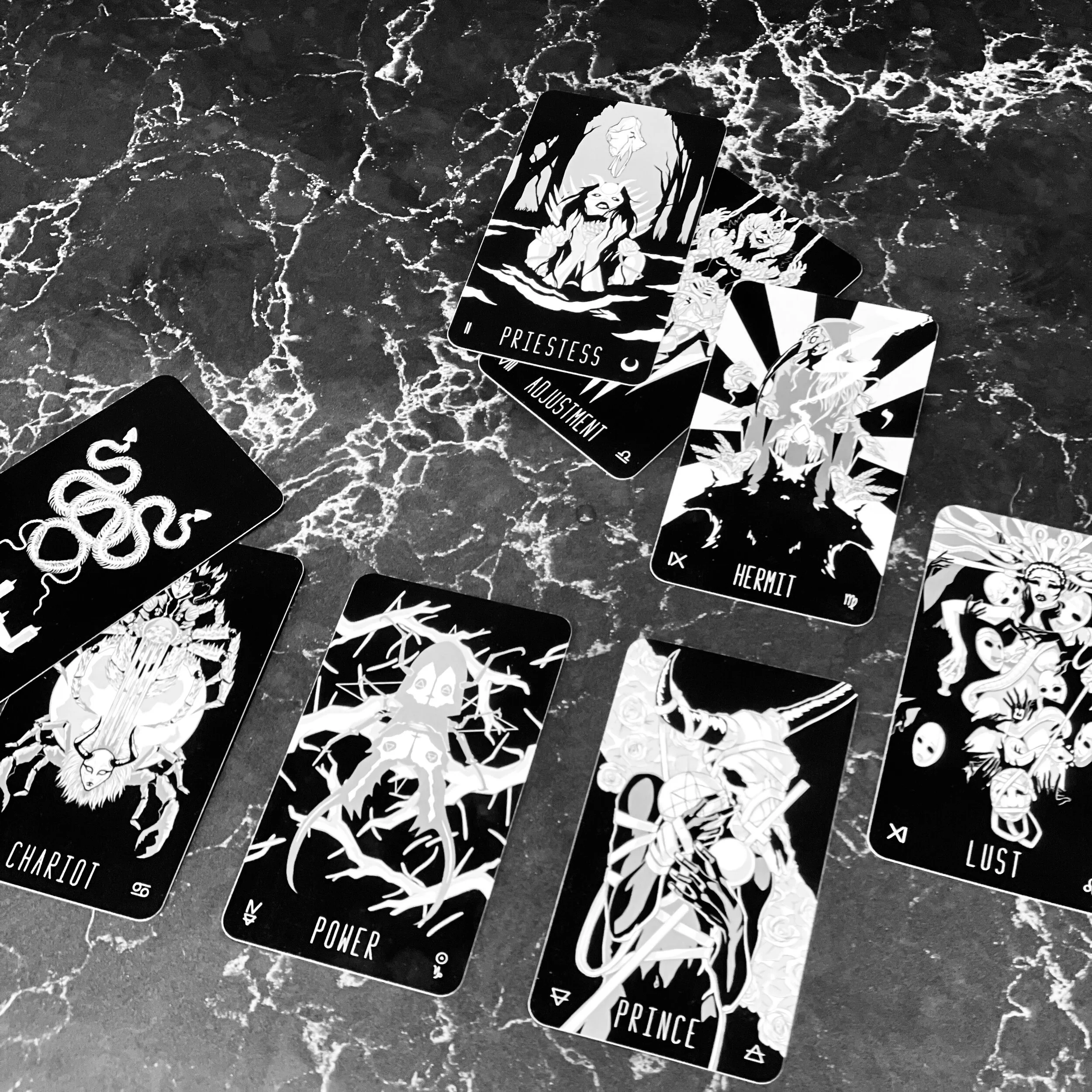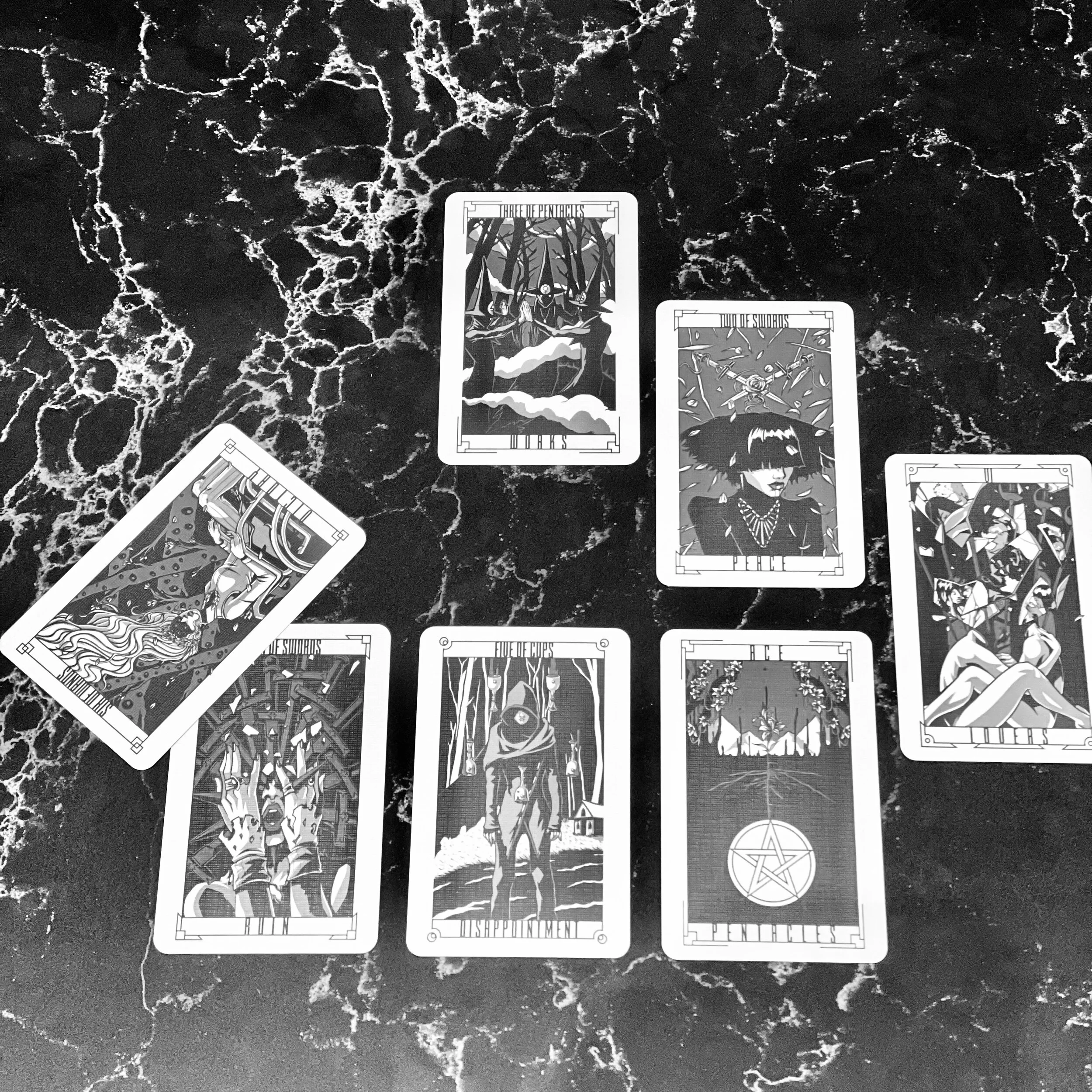Realignment with a Re-Interview of the Wayward Dark Tarot and Lost Hollow Tarot
The deck interview spread I created a while back is probably my most used spread, and I sometimes get asked how long I wait before interviewing a deck again. Honestly, I almost never do. I think it’s because I generally don’t need to. There might be new lessons to learn from a deck at a given point, but I discover them naturally. By the time I’ve learned the first lesson from a deck, I’ve worked with it enough that I don’t need such a direct discussion as the interview spread encourages. We can just talk like friends or longtime colleagues, filling in gaps, observing new behaviors, and learning from shared experiences. But relationships evolve over time. And there are times when my relationship to a deck changes in a dramatic way, such as when I re-interviewed the Spirit Keeper’s Tarot after completing that deck’s built-in initiation process.
I think a fresh look at the Wayward Dark Tarot is warranted. It’s been a while since I first interviewed the Wayward Dark Tarot by James Brothwell (@PixelOccult), but in preparation for our live chat on Instagram, I wanted to check in with that deck and the Lost Hollow Tarot (interviewed almost exactly a year later) and see whether they’re speaking differently to me now.
A fresh interview with your tarot deck may be all well and good, but it has a much more significant purpose than just interviewing the deck. A deck is, after all, a collection of paper or cardstock or plastic, just inert matter. When you interview your deck, you are interviewing yourself. So when you re-interview a deck, you have an opportunity to examine how you’ve changed. That’s why the relationship may be different, and that’s what’s potentially valuable about conducting a re-interview.
As for when you think you’re ready to interview a deck again, there’s no one answer. Instead, I would ask yourself if you think that your relationship to the deck (and the potential that the deck first offered you) has changed. Are you ready to re-interview yourself and re-examine how you respond to the deck? A deck is a tool to help you work your magic, whether that’s magickal work or the more figurative meaning of the phrase “work your magic.”
For me, I am ready to re-examine and see what has changed and what hasn’t in my relationship to these two decks.
Reviewing the Wayward Dark Tarot
When I first interviewed the Wayward Dark Tarot, I was simultaneously attracted to and repelled by the imagery. It is icy but earthy, chthonic as promised by the description, and I felt that it had a lot of dark magical potential within it of which I might want to be wary.
At the time, the weight of that darkness and mystery was off-putting, but I’ve come to see now that there is more to it. And I’m in a place now to better understand its nuance. Bones aren’t scary. They’re part of us, just as death and decay are a necessary part of nature. Windswept hair and flares of power and slices of bodies don’t have to be either. They’re elemental. They’re power. Abuse of power is what makes such imagery scary. The ability to dissect, to reveal bones, and to disassemble does not have to be destructive. It can be regenerative, and I’ve learned in the last year or so—perhaps since my interview with the Lost Hollow Tarot—that my own inner world and psychic landscape is deconstructive. At a certain point, things must be stripped bare, burned away, or broken down in order to make room for new growth.
I knew this when I did the Wayward Dark Tarot because I’d already been working very closely with a deconstructive spirit guide energy I have come to think of as Vulcan, the god of fire and the forge. But I’d somehow forgotten. Or I’d been confused by the seeming antithesis of the cards and that fiery masculine concept.
Looking back at the cards that I drew for that initial interview, I realize how much feminine power and softness is in them, even though the cards give the impression of cold ice. I was a little scared of the Empress and her sacred circle with its sacrificial pelican. But she is nature, and the pelican according to myth actually sacrifices itself. It’s dark goddess magic, and that can be scary when you haven’t encountered that part of yourself or when you’re working primarily through bright god magic (Vulcan was often partnered in my work with Helios or Apollo). But as I’ve said now a dozen times, it doesn’t have to be so unsettling. Seeing the Star card rising up from the dark waters and with its butterflies after the sliced butterfly of Interference (8 Air) reminds me of that regenerative potential.
The Star also makes it feel like this is the right moment to re-examine this deck now that I have come to understand the darker side of the Empress along with the light and power of the Star. (I never used to understand the Star’s appeal, but I do now.) I’ve seen the Star in the cold of night with the moon rising behind to light the path ahead. That it’s the Aquarius Full Moon the weekend that I conducted the interview (and started the first draft of this post) makes it perfectly literal.
Re-interviewing the Wayward Dark Tarot
The crux of my re-interview revolves around the central lesson of Power. In the Thoth system, the 4 of Earth (Disks) is called Power, the accumulation and fortification of one’s material world, the doubly stabilizing power of the number four and of earth. As before, there is an emphasis on the magical and feminine in the cards that emerged, especially with the pairing of the Priestess and Lust. And the Earth and Fire elements feel strong, recalling the Queen and 4 of Fire, the Empress, and the Devil from the first interview.
Whereas that earlier interview may have been about cultivating power and navigating the source of that power, this new interview suggests the importance of inner capacity and determining how to actually put it into action wisely or, if not wisely, with rational forethought. It’s a shift from navigating potential pitfalls and dangers in accessing magic or other energetic reserves to recognizing that there are always costs. Instead of avoiding those costs, it’s time to demonstrate being wise (or calculating) enough to know when it’s worth using a limited resource or worth paying the price of access.
Of course, there’s still a warning. Lust is the sign for another shift in my relationship with the deck, and it is itself a form of power in delicate balance. Lust can be interpreted as one’s life force in the Thoth system, but in this deck it has a more literal interpretation. That delicate balance of power that awaits the Magus’s path will continue to challenge me (it’s a helpful reminder that Adjustment is there ready and waiting behind the Priestess as a divine connection point).
Entities are attracted to power, that life force, like moths to a flame. In this depiction, they’re leeches, clinging on to that inner fire and either sucking it dry or corrupting it. It’s clear that the earlier warnings about the kind of work I could do with this deck are still in place because it’s still a deck that will invite me to explore power. I’ve just evolved enough to allow for the next phase of that lesson. I suspect that this fundamental interplay of responsibility and power will continue, and I’m glad that I know where to turn to test that balance point.
Reviewing the Lost Hollow Tarot
With the Lost Hollow Tarot, the initial reading was quite a contrast. First, it was very major (only two of seven cards were minor arcana) and the messaging was almost completely opposite the Wayward Dark Tarot. Almost exactly a year had past between interviews, so that’s not shocking, but considering some of the visual similarities between the decks, it surprised me at first.
Looking back now, I see the central lesson of the Lovers, one of my favorite depictions of that major as I discuss in my post on “Learning to Read the Lovers,” as being about fragmentation and reclaiming identity in relationship to but separate from others. There’s a host of options within the mirror fragments erupting from the Lovers, and I’m all about it. In November of last year (when I did the interview), I was getting ready to launch my course on conducting ancestor and past life readings, something I’ll launch again later this year. Much of how I understand the sometimes nebulous connection of my work and the value I add for others is through that type of work. I love conducting past life readings (“Scenes from Another Life”) and ancestor readings (“Tales from the Well”), and I lean fully into my spiritual practice to make them possible. But it is all about fragmentation. Like the cards of that particular reading, it’s a potentially disruptive process, and it requires thoroughly set boundaries for me and an ability to reconnect the past and whatever traumas and revelations it brings up for the client who is offering me access to this hidden part of themself.
The Adjustment card suggested that same delicate balance that I’m working through with the Wayward Dark Tarot. It’s a dance, and before I did either re-interview, I felt that it might not be time for the Lost Hollow’s next lesson (Adjustment is the Libra card). But I felt comfortable and confident in knowing that I had learned significantly about that fragmentation and the rejoining required afterwards, so I was excited to see what would be next on the docket for this little deck I love, even if I might want to wait until Libra season to actually get started.
Re-interviewing the Lost Hollow Tarot
And indeed, I think the re-interview was too soon. The final card was the Lovers again, and I felt the idea that I needed to learn more about the lesson I felt I had learned over the past nine or so months, that lesson about fragmentation and bringing the pieces back together. I know the spirit work that I need to do on that front, but I keep putting it off. While I won’t go into this interview's specifics, it feels very resonant personally with the lesson of Disappointment (5 of Cups) and the deconstructive divine connection point of Works (3 of Pentacles), the card I drew that gave me the idea of Vulcan when I completed Spiral Sea Tarot’s Spirit Guide Challenge (you can read about it in my blog post, “My Guide, My Self”).
The Lost Hollow Tarot is a much more everyday deck than the Wayward Dark Tarot, a pocket-size tool to throw in a bag (or pocket) and take around with me, and the imagery is less otherworldly if still haunting. It’s a deck that I can go to for practical concerns and moving past small problems as well as the known, existing mysteries I’m working through. It’s still tied to who I am and what I bring to tarot, both for myself and when reading for others. It’s rare that I read for others using this deck, but this re-interview makes me think that I should start to bring it out more regularly for others. The messages in this re-interview align well with a lot of my intended goals and favored practices. For the Lost Hollow Tarot, this was not so much a re-interview as a reminder interview. There’s still a lot of work to be done, and the deck is ready and willing to do that work whenever I am.
The decks shown are the Wayward Dark Tarot and the Lost Hollow Tarot by James Brothwell / PixelOccult © 2019 and 2020, respectively.


